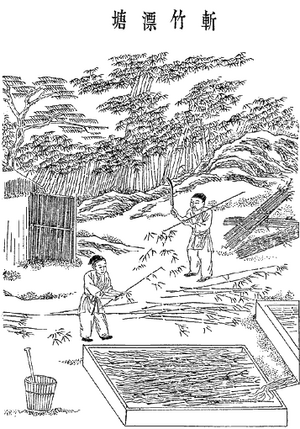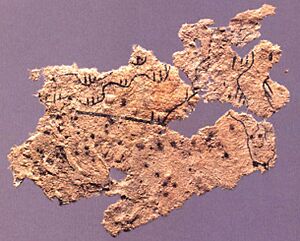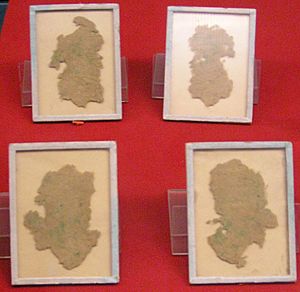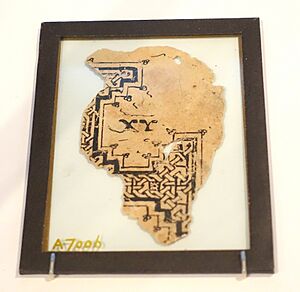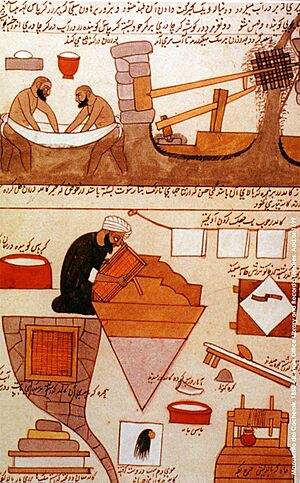History of paper facts for kids
Paper is a thin, flat material usually made from plant fibers. It's super important for writing, drawing, and even money! The very first paper-like material was called papyrus, made in ancient Egypt from a plant. But the way we make paper today, by breaking down plant fibers into a pulp, was first invented in China.
This amazing invention happened during the Han dynasty (around 25–220 AD). A court official named Cai Lun is often given credit for it. From China, papermaking spread to the Islamic world in the 8th century, replacing papyrus. By the 11th century, it reached Europe, where it took the place of animal-skin parchment. Later, in the 19th century, new ways to make paper from wood made it even cheaper and more common.
Contents
What Came Before Paper?
Before true paper, people used other materials to write on.
Papyrus
The word "paper" actually comes from "papyrus," which is an Ancient Greek word for the Cyperus papyrus plant. Papyrus was a thick, paper-like material made from the inside of this plant. It was used in ancient Egypt and other Mediterranean countries for writing long before paper appeared in China.
To make papyrus, thin strips were cut from the plant's pith (the soft inside). These strips were laid side-by-side to form a sheet. Then, a second layer was placed on top, with the strips going the other way. The two layers were pounded together with a mallet to create a strong sheet. Papyrus was very strong, but its surface was uneven. When used in scrolls, it would often crack along the strip lines.
Paper is different because the plant material is completely broken down before it's pressed. This makes a much smoother surface. Papyrus was made by pressing and pounding the plant, which only grew well in Egypt and Sicily. Paper was more affordable and easier to get. Papyrus was also fragile and didn't like moisture.
By the end of the 9th century, paper became more popular than papyrus in the Muslim world. In Europe, papyrus was used alongside parchment for a few hundred years. But it mostly disappeared by the 11th century.
Paper in China
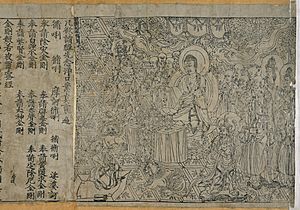
We have found old pieces of paper that are even older than the time of Cai Lun. So, we don't know the exact date or person who invented paper. The oldest piece of paper found was in Gansu province. It was probably part of a map and dates back to 179–141 BCE. Other paper pieces have been found from 65 BCE and 8 BCE.
Cai Lun is traditionally credited with improving papermaking in 105 CE. He found a way to make paper from mulberry and other plant fibers. He also used old fishing nets, rags, and hemp waste. This made paper much cheaper to produce. Before this, and later in the West, paper relied only on rags.
How Paper Was Made in China
In ancient China, during the Shang dynasty and Zhou dynasty, people usually wrote on heavy bamboo tablets. They would sew bamboo strips together to make scrolls. These were very heavy and hard to carry. Sometimes, they used light silk for writing, but it was too expensive.
Cai Lun (around 50–121 CE) is famous for inventing a new way to make paper in 105 CE. He was inspired by how wasps and bees build their nests. He used rags and other plant fibers. However, paper fragments found in 2006 suggest paper was used by the Chinese military over 100 years before Cai Lun, possibly as early as 8 BCE. So, it seems Cai Lun's big contribution was to make the process better and create a clear recipe for papermaking.
Cai Lun's story says: "In old times, writings were usually on bamboo tablets or silk. But silk was costly and bamboo was heavy. So, Cai Lun thought of making paper from tree bark, hemp scraps, cloth rags, and fishing nets. He showed this process to the emperor in 105 CE and was praised. From then on, paper has been used everywhere and is called 'Marquis Cai's paper'."
The process likely started by pounding and stirring rags in water. Then, the matted fibers were collected on a mat. The bark of paper mulberry trees was especially good for making high-quality paper. While bark paper appeared during the Han dynasty, hemp was the main material until the Tang dynasty. Then, rattan and mulberry bark became more common.
After the Song dynasty, when printing became popular, the need for paper grew a lot. There wasn't enough bark, so new kinds of paper using bamboo were invented during the Song dynasty.
What Paper Was Used For
One of the earliest uses of paper was for padding and wrapping delicate bronze mirrors. This was around the 2nd century BCE. Paper protected the objects and also the user if poisonous "medicine" was involved. Even though paper was used for writing by the 3rd century CE, it continued to be used for wrapping.
Toilet paper was used in China from around the late 6th century! A Chinese scholar wrote in 589 that he dared not use paper with wise sayings for toilet purposes. An Arab traveler in 851 noted that the Chinese used paper instead of water after using the toilet.
During the Tang dynasty (618–907), paper was folded into square bags to keep tea fresh. Tea was also served in colorful paper cups and with paper napkins. During the Song dynasty (960–1279), the government made the world's first paper money, or banknote. Paper money was even given as gifts in special paper envelopes.
When Marco Polo visited China during the Yuan dynasty (1271–1368), he saw the Chinese burning paper figures of servants, camels, and clothes during funerals.
How Paper Changed China
Paper changed Chinese culture a lot. It made books much easier to handle. Books no longer had to be in small bundles. They could be carried by hand instead of by cart. This meant people could own many more books.
By the early 5th century, some people in the south of China owned thousands of scrolls. Scholars could quote hundreds of sources in their writings. Paper helped China become a world leader in book production. The spread of woodblock printing also boosted this even more.
Paper became very important for Chinese arts like poetry, painting, and calligraphy. It was considered one of the "Four Treasures of the Scholar's Studio," along with the brush, ink, and inkstone.
Paper in Asia
From China, paper spread steadily across Asia. It was used in Dunhuang by 150 CE and in Japan between 280 and 610.
Eastern Asia
Paper reached Vietnam in the 3rd century, Korea in the 4th century, and Japan in the 5th century. Korean paper was famous for being glossy white. It was highly valued for painting and calligraphy. Korean paper was often sent to China as a special gift. A Buddhist monk named Damjing is often credited with officially bringing papermaking to Japan in 610.
Islamic World
Paper was used in Central Asia by the 8th century. Some stories say Chinese prisoners captured at the Battle of Talas in 751 taught paper manufacturing in Samarkand. However, there are no clear records from that time to confirm this. Other evidence suggests paper was already known in Samarkand before 751 CE.
The way paper was made in China and Central Asia was different. Chinese paper used mostly plant fibers, while Islamic paper used waste materials like rags. It's thought that Buddhist merchants and monks helped spread paper knowledge. The Islamic civilization then helped spread paper and papermaking across the Middle East after the 8th century. By 981, paper had reached Armenian and Georgian monasteries.
Paper Replaces Parchment
During the 8th century, paper began to replace parchment for official documents in Baghdad, the capital of the Abbasids. Parchment was rare. Because more and more people were writing letters, the Grand Vizier ordered paper to be made to replace parchment.
Records show paper was made in Gilgit (Pakistan) by the 6th century, Samarkand by 751, Baghdad by 793, Egypt by 900, and Fes, Morocco, around 1100. A 10th-century Persian book, Hodud al-Alam, mentions Samarkand was famous for its high-quality paper.
In Baghdad, there were special areas for paper making. The "Paper Market" had over 100 paper and booksellers' shops. In 1035, a Persian traveler noted that vegetables and spices in Cairo were wrapped in paper for customers.
The increase in paper availability led to more public and private libraries and illustrated books in Islamic lands. However, paper was still expensive to make because it needed a lot of materials and labor.
How Islamic Paper Was Made
Islamic papermaking used materials like hemp, flax, cotton, and old rags. Sometimes, they mixed materials like cotton and hemp.
A painting from a Persian book shows the steps of traditional papermaking. First, linen waste and rags were mixed with water in stone pits. This made a watery pulp. Then, the pulp was poured onto fabric to remove water and clean it. After that, the pulp was molded into sheets using a special screen, pressed, sized (treated to make it smoother for writing), dried, and polished. For drying, paper was stuck to a wall using horsehair.
A 13th-century manuscript describes how to make high-quality paper from fig tree bark. This process took 12 days to make 100 sheets. The beaten fibers were made into "cubes" of different sizes. These cubes were used to measure how many sheets could be made.
Paper Qualities
Paper from the Near East was often treated with starches like rice or wheat to make it smooth. It was rubbed with a smooth tool called a mohreh until it became perfectly shiny.
The process of papermaking became more efficient. Machines were designed for larger production. In Baghdad, a method was invented to make thicker paper. This helped turn papermaking from an art into a big industry. Water-powered pulp mills for preparing the pulp were used in Samarkand by the 8th century. Muslims also started using trip hammers (powered by humans or animals) to beat the paper pulp. This replaced the Chinese mortar and pestle method. Later, the Chinese also adopted the trip hammer method.
By the 9th century, Muslims used paper regularly. However, for important works like copies of the Qur'an, vellum (animal skin) was still preferred. Books became lighter, sewn with silk and bound with leather.
Paper manufacturing in Damascus was interrupted by wars, but it continued in Egypt (thicker paper) and Iran (thinner paper). Paper spread across the Islamic world and then to Europe. Arab merchants brought paper manufacturing to India in the 13th century.
Indian Subcontinent
Paper was used in India by the second half of the 7th century. Chinese Buddhist travelers mentioned Indians printing Buddha images on silk or paper. They also used paper for hats, umbrellas, and for cleaning.
Thin sheets of birch bark and treated palm-leaves were still preferred for writing in most of India. The oldest Sanskrit paper manuscript found is from Kashmir, dated to 1089. Some of the oldest surviving paper manuscripts are in Jain temples in Gujarat and Rajasthan, showing paper use by Jain scribes around the 12th century. Jewish merchants imported large amounts of paper into Indian ports by the 11th century.
It's thought that paper manufacturing reached Sindh (now in Pakistan) before the 11th century. Fragments of Arabic manuscripts found in the ruins of Mansura confirm paper use there.
In the 15th century, a Chinese traveler praised the quality of paper in Bengal. He said it was white, made from "bark of a tree," and as "glossy and smooth as deer's skin." This suggests paper technology might have come directly from China to eastern India. Paper technology likely arrived in India from China through Tibet and Nepal around the mid-7th century. Buddhist monks traveled freely and exchanged ideas.
Kaghaz
The Tamil word for paper, "kaghaz," comes from the Persian word. This Persian word was borrowed into many other languages, including Arabic, Bengali, Georgian, and various Turkic languages.
Historian Nile Green explains that more access to paper helped the Persian language spread in writing across large parts of Asia.
Paper in Europe
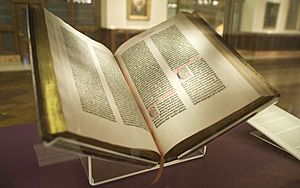
The oldest known paper document in Europe is from the 11th century. It was probably made in the Islamic part of Spain. They used hemp and linen rags for fibers. The first paper mill in Spain was in Xàtiva in 1056.
Papermaking reached Europe by 1085 in Toledo and was well-established in Xàtiva, Spain, by 1150. During the 13th century, mills were built in Italy. Papermaking then spread northwards to France by 1348, Holland around 1340–1350, and Germany by 1390. The first paper mill in England was set up around 1490.
Arab prisoners in Italy taught local artisans how to make paper by hand. These artisans refined the process. They used stamping hammers to turn rags into pulp. They also started sizing paper with animal glue and creating watermarks. Watermarks were made by putting metal wires on the mold used to form the paper.
They used waterwheels from other mills to power wooden hammers. These hammers would beat the rags into pulp.
Paper in the Americas
Amate
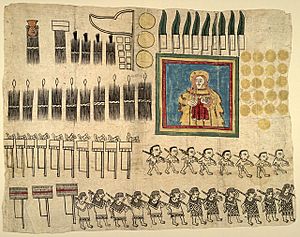
In the Americas, the Maya used a similar bark-paper writing material called amatl or amate by the 5th century CE. It was widely used by Mesoamerican cultures until the Spanish conquest. The oldest piece of amate found is from 75 BCE.
There's some debate if Mesoamerican paper is "true" paper. The Mayans used a material called huun from the inner bark of the wild fig tree. It was cut and stretched thin, not made from randomly woven fibers. The Mayans made codices (books) from huun. The Toltecs and Aztecs also had their own paper. Aztec amatl was used for writing, decorations, rituals, and masks. Like Mayan paper, it was made from fig tree bark, beaten, stretched, and dried. Paper made from agave was also used, but it was rough and probably not for writing. After the Spanish conquest, the Aztecs started using paper imported by the Spanish.
United States
European papermaking came to the Americas, first to Mexico by 1575, and then to Philadelphia by 1690.
The American paper industry started with the first paper mill in 1690 in Philadelphia. For two decades, it was the only mill. For the next two centuries, Philadelphia was a major center for paper making and publishing. Early mills used only rag paper, often from cotton rags imported from Europe.
By the mid-19th century, the sulfite process (using wood pulp) became popular. By 1880, America was the world's largest paper producer. While Philadelphia remained important, other regions with better access to wood pulp and water power grew.
Many early mills were in New England and Upstate New York. International Paper, one of the largest paper companies, started in New York. Holyoke, Massachusetts, was a major papermaking city, once making 80% of the writing paper in the United States. It became a hub for paper machinery and turbine technology.
The paper industry continued to grow in other areas like California, Ohio, and the South. Today, Wisconsin has the most paper manufacturers in the country.
Paper Mills
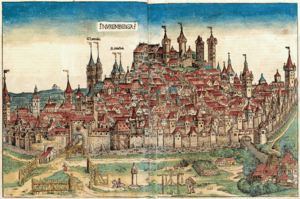
Both Chinese and Muslim papermakers used mills powered by humans and animals. However, clear evidence for water-powered paper mills before the 11th century is rare. Scholars have found evidence of paper mills in Baghdad around 794–795, likely human or animal powered. Water-powered mills were widely used in Islamic lands to beat flax and rag waste for paper pulp.
Some historians believe there might be a reference to a water-powered paper mill in Samarkand in an 11th-century Persian text. But it's not certain.
Clear evidence of a water-powered paper mill dates to 1282 in Spain. A king's order mentions a royal "watermill" in the paper-making town of Xàtiva. This mill was run by the Muslim community.
The first paper mill north of the Alps was in Nuremberg, Germany, in 1390. From the mid-14th century, European paper milling improved quickly.
Where Did the Fibers Come From?
Before paper production became industrialized, the most common fiber source was recycled textiles, called rags. These rags came from hemp, linen, and cotton. It wasn't until wood pulp was introduced in 1843 that paper production stopped relying on recycled rags. People didn't realize at the time how unstable wood pulp paper could be.
A way to remove printing inks from paper, so it could be reused, was invented in Germany in 1774. Today, this process is called deinking.
19th-Century Paper Advances
Even though paper was cheaper than vellum, it remained expensive for books for centuries. This changed with the invention of steam-driven paper-making machines in the 19th century. These machines could make paper from wood pulp.
Nicholas Louis Robert in France got a patent for a continuous paper-making machine in 1799. An improved version was installed in England in 1803. This machine became the basis for most modern papermaking.
Early experiments with wood for paper didn't work well. But in the 1830s and 1840s, Friedrich Gottlob Keller and Charles Fenerty independently found a new way. They invented machines that extracted fibers from wood, just like from rags. By mid-1844, they announced their discoveries. Charles Fenerty also bleached the pulp to make the paper white. This began a new era for papermaking. By the end of the 19th century, most printers in the Western world used wood instead of rags for paper.
Along with the invention of the fountain pen and mass-produced pencil, and the steam-driven rotary printing press, wood-based paper greatly changed the economy and society in the 19th century. With cheaper paper, schoolbooks, novels, non-fiction books, and newspapers became widely available by 1900. Cheap wood-based paper also made it possible for more people to keep diaries or write letters.
Early wood-based paper often broke down over time. This is because the acid in the paper, caused by using alum, slowly turned the paper to ash. Important documents had to be written on more expensive rag paper. In the late 20th century, cheaper acid-free paper made from wood was developed. This is now used for many books. However, paper that hasn't been de-acidified is still cheaper and is used for mass-market paperbacks and newspapers.
Images for kids
See also
- Kaghaz
- Barkcloth
- History of origami
- Paperless office
- Papyrus
Sources
- (alk. paper)
- Bloom, Jonathan (2001). Paper before print: the history and impact of paper in the Islamic world. Yale University Press.


